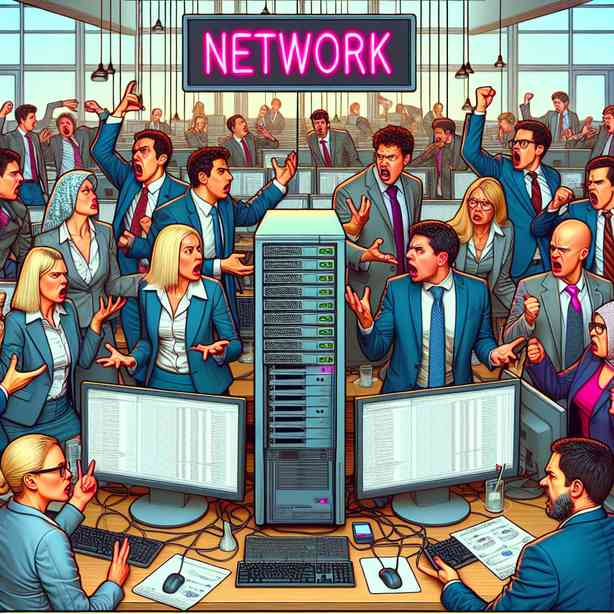
When Everyone Blames the Network
In today’s hyper-connected world, the network serves as the backbone of our personal and professional lives. Whether it be for communication, entertainment, or essential business operations, we heavily rely on the network to function seamlessly. However, when something goes awry—be it a slow connection, a dropped call, or a complete outage—the blame often falls squarely on the network itself. This phenomenon of network scapegoating merits a closer examination, as it reveals insights into our reliance on technology and the underlying issues that could be contributing to these frustrations.
To start, it’s essential to understand the complexities of modern networks. In recent years, networks have evolved from simple, centralized systems into intricate webs of connectivity. With the advent of cloud computing and the Internet of Things (IoT), millions of devices are now interconnected, sharing and transmitting vast amounts of data. As this complexity increases, so too do the potential points of failure. While it might be tempting to blame the network for issues we encounter, it’s crucial to appreciate that many contributing factors could lead to connectivity problems.
One common misconception is that all network problems originate from the service provider. While it is true that issues like service outages or maintenance tasks can impact connectivity, other factors within our own homes or businesses can cause significant disruptions. Local routers can malfunction, Wi-Fi signals can be obstructed by physical barriers, and numerous devices connecting to a single network can lead to congestion. These are just a few examples of how internal factors play a significant role in the performance of our networks.
Additionally, human behavior can affect network performance. For instance, how often do we consider the impact of online activities from multiple users? With a growing number of smart devices in our homes—think of smart TVs, gaming consoles, and mobile devices—bandwidth consumption can quickly escalate, leading to slower speeds for everyone connected. In many instances, the blame placed on the network may simply arise from unawareness of these dynamics.
It’s also worth considering that user expectations have evolved alongside technology. The modern user has grown accustomed to instant connectivity and seamless streaming and has very little tolerance for delays or interruptions. This high standard often leads to immediate frustration and an instinctive reaction to blame the network when things do not work out as expected. This phenomenon, while understandable, overlooks the nuances of how modern networks operate and the external factors that can impact performance.
Another aspect to consider is the role of misinformation in shaping perceptions around network issues. During an outage or connectivity problem, many users may turn to social media or other online platforms to voice their frustrations. In the heat of the moment, this can create a ripple effect of panic and blame that may not accurately reflect the reality of the situation. As people share their experiences, myths about network performance can proliferate, leading to a collective misunderstanding about how networks function and what truly drives issues.
To navigate these challenges effectively, fostering a greater understanding of network technology is essential. The more knowledgeable we become about how our networks work—and the range of factors that can lead to disruptions—the better equipped we’ll be to troubleshoot problems. Learning about router settings, understanding network congestion, and even recognizing when to contact customer service can all play pivotal roles in mitigating issues before they escalate.
Promoting better communication between service providers and users can also help to alleviate misconceptions about network reliability. Many service providers have routing tools and diagnostic tools that enable customers to see potential issues on their end, allowing users to take proactive measures. Additionally, fostering a culture of transparency helps users feel more confident about issues that might arise. By sharing real-time updates and potential fixes when problems occur, service providers can help alleviate the immediate frustrations that lead to blame.
Furthermore, empowering users with knowledge about network maintenance can contribute to a more harmonious relationship between the network and its users. Providing tips on optimizing home networks—such as placing routers in central locations, limiting bandwidth-hogging applications, or regularly updating firmware—can enable users to take control of their experiences. In fostering greater awareness and understanding, we can shift the narrative from blaming the network to appreciating the multifaceted nature of connectivity.
In conclusion, while it may be easy to point fingers at the network when issues arise, it’s vital to look more deeply into the underlying causes of these frustrations. By understanding the complexity of modern networks and recognizing the contribution of both external and internal factors, we can begin to unravel the misconceptions that lead to misplaced blame. Education, open communication with service providers, and proactive network management will not only reduce frustration but also empower users to harness the full potential of their technologies. Acknowledging the shared responsibility of both users and providers ultimately leads to a more connected world—one where we can work together to resolve issues rather than place blame.


